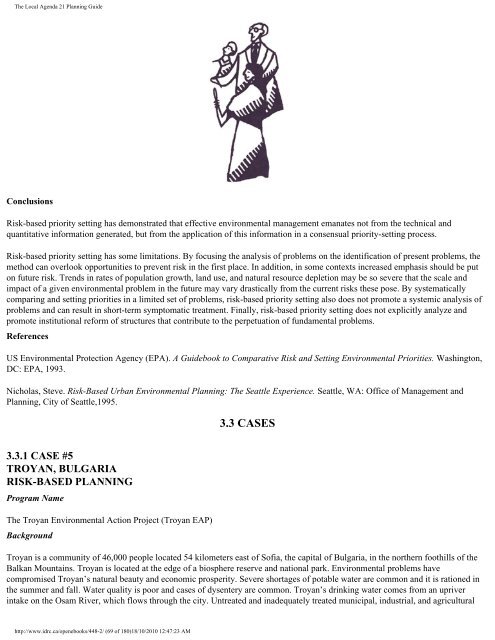The Local Agenda 21 Planning Guide - Democrats Against UN ...
The Local Agenda 21 Planning Guide - Democrats Against UN ...
The Local Agenda 21 Planning Guide - Democrats Against UN ...
Create successful ePaper yourself
Turn your PDF publications into a flip-book with our unique Google optimized e-Paper software.
<strong>The</strong> <strong>Local</strong> <strong>Agenda</strong> <strong>21</strong> <strong>Planning</strong> <strong>Guide</strong><br />
Conclusions<br />
Risk-based priority setting has demonstrated that effective environmental management emanates not from the technical and<br />
quantitative information generated, but from the application of this information in a consensual priority-setting process.<br />
Risk-based priority setting has some limitations. By focusing the analysis of problems on the identification of present problems, the<br />
method can overlook opportunities to prevent risk in the first place. In addition, in some contexts increased emphasis should be put<br />
on future risk. Trends in rates of population growth, land use, and natural resource depletion may be so severe that the scale and<br />
impact of a given environmental problem in the future may vary drastically from the current risks these pose. By systematically<br />
comparing and setting priorities in a limited set of problems, risk-based priority setting also does not promote a systemic analysis of<br />
problems and can result in short-term symptomatic treatment. Finally, risk-based priority setting does not explicitly analyze and<br />
promote institutional reform of structures that contribute to the perpetuation of fundamental problems.<br />
References<br />
US Environmental Protection Agency (EPA). A <strong>Guide</strong>book to Comparative Risk and Setting Environmental Priorities. Washington,<br />
DC: EPA, 1993.<br />
Nicholas, Steve. Risk-Based Urban Environmental <strong>Planning</strong>: <strong>The</strong> Seattle Experience. Seattle, WA: Office of Management and<br />
<strong>Planning</strong>, City of Seattle,1995.<br />
3.3 CASES<br />
3.3.1 CASE #5<br />
TROYAN, BULGARIA<br />
RISK-BASED PLANNING<br />
Program Name<br />
<strong>The</strong> Troyan Environmental Action Project (Troyan EAP)<br />
Background<br />
Troyan is a community of 46,000 people located 54 kilometers east of Sofia, the capital of Bulgaria, in the northern foothills of the<br />
Balkan Mountains. Troyan is located at the edge of a biosphere reserve and national park. Environmental problems have<br />
compromised Troyan’s natural beauty and economic prosperity. Severe shortages of potable water are common and it is rationed in<br />
the summer and fall. Water quality is poor and cases of dysentery are common. Troyan’s drinking water comes from an upriver<br />
intake on the Osam River, which flows through the city. Untreated and inadequately treated municipal, industrial, and agricultural<br />
http://www.idrc.ca/openebooks/448-2/ (69 of 180)18/10/2010 12:47:23 AM










